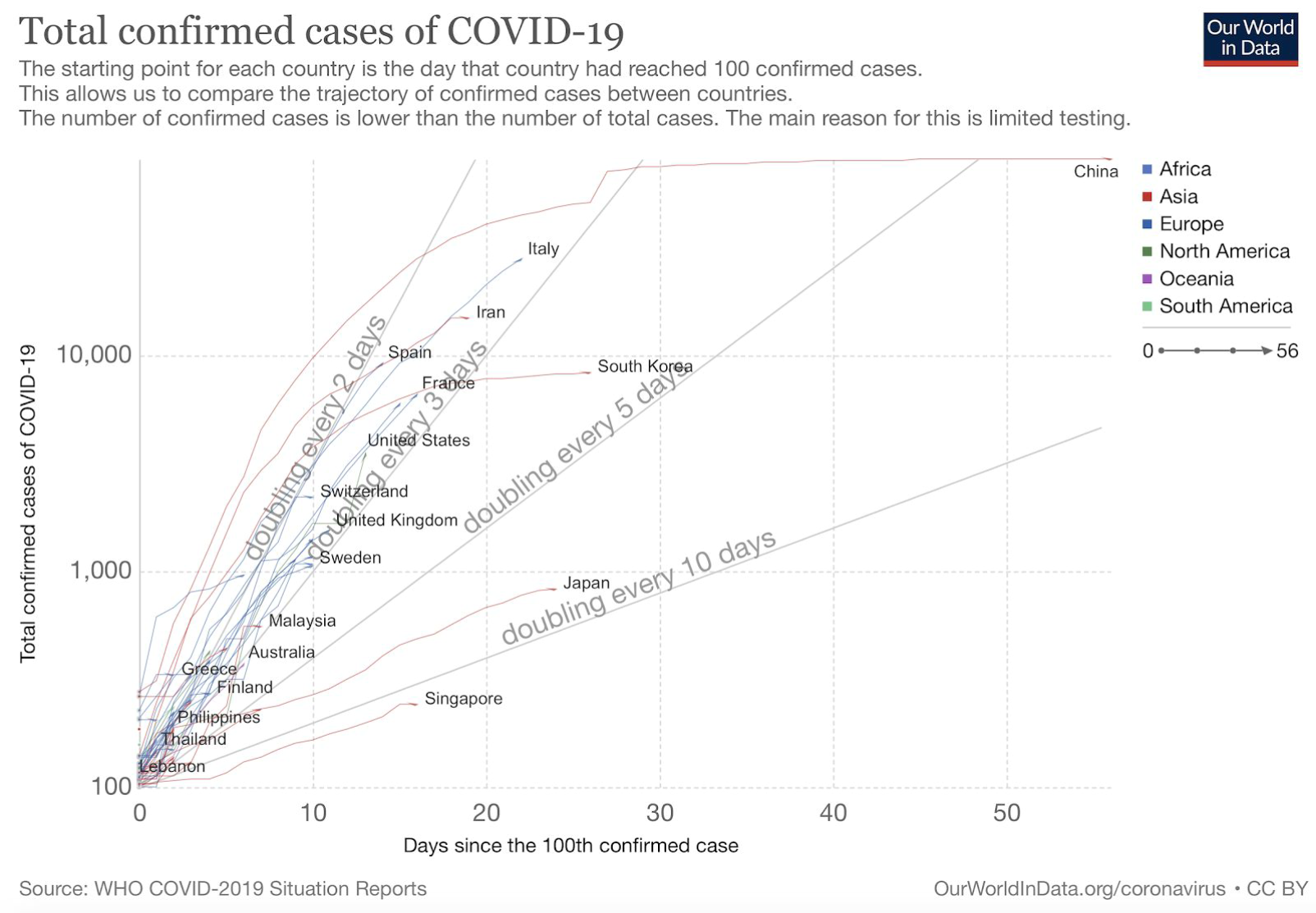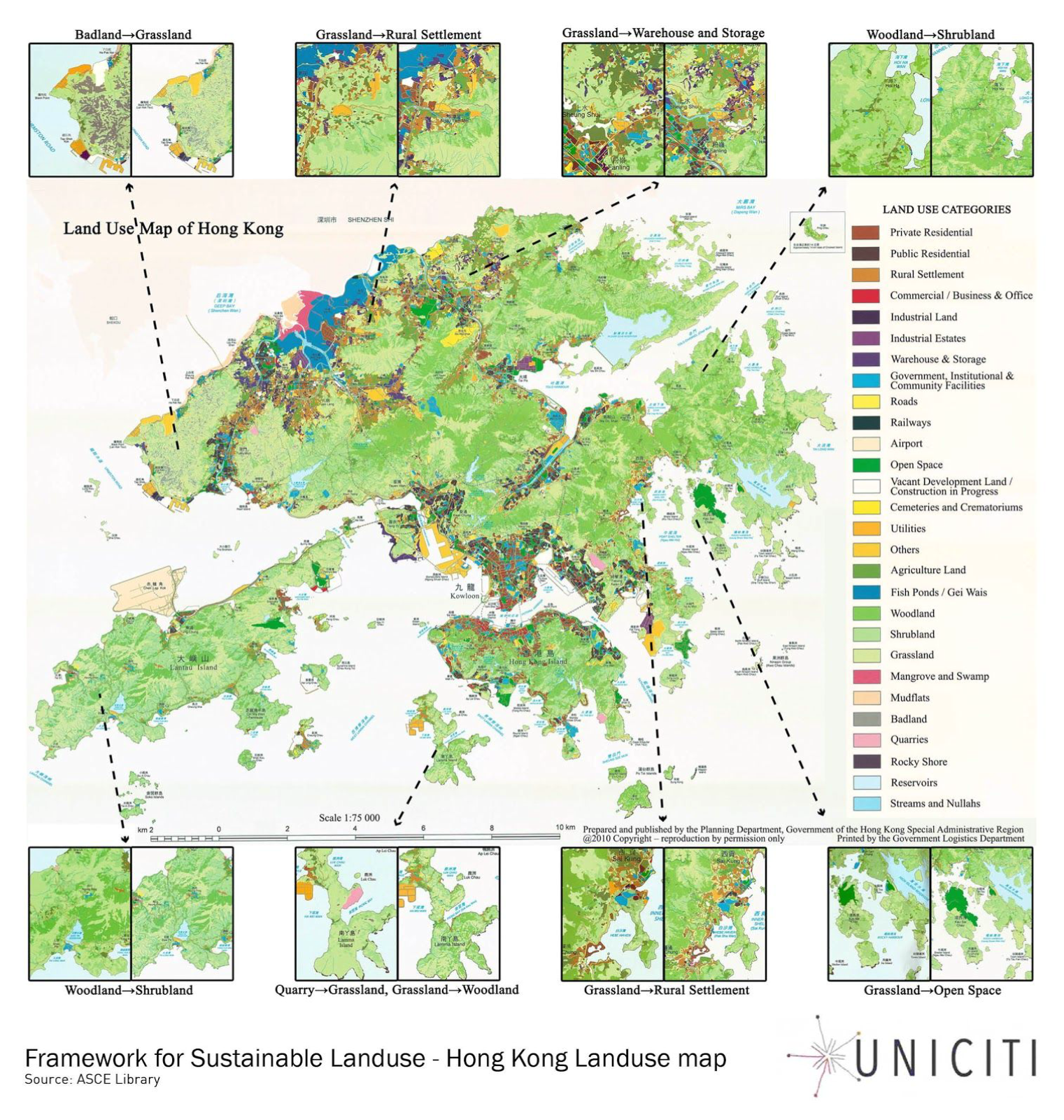COVID-19 and climate resilience: Effective disaster prevention and management practices
Read time: 7 minutes
Guest author: Olga Chepelianskaia (UNICITI)
Editor's note: This post shares the findings of two related articles that link the current crisis with climate resilience. These investigate: 1) human encroachment into natural ecosystems; and 2) resilience planning in Hong Kong, Taiwan and Singapore.
As we’ve crossed 1 million cases of COVID-19, entire countries and cities are locked down. Hashtags #SocialDistancing and #FlattenTheCurve have hit top popularity. Our lifestyles shattered, we can only wonder how we could have possibly avoided this crisis and what structural elements can help us not only emerge from it, but also prevent future disasters of different kinds.

Confirmed cases of COVID-19 Source: Our World In Data
Looking at the elements that led to the crisis, we realised that these are closely related to the way we interact with our natural ecosystems. And, looking at how the crisis is handled at its best, we saw that the same elements allow the same countries to successfully mitigate climate change effects. Two articles below shared our findings.
Human encroachment into natural ecosystems
Did you know that 60% of emerging infectious diseases affecting humans are zoonotic? This means they originate in animals. And, importantly, over 2/3 of these originate in wildlife. Peter Daszak, a disease ecologist and the president of EcoHealth, states that every emerging disease in the last 40 years came from human encroachment into wildlands. For example:
- Nipah Virus pilled over from fruit bats when the forest was cleared for pig farming;
- Ebola Virus outbreaks often are linked to hunting for “bushmeat” or to mining development;
- Hendra Virus caused the death of 4 people and dozens of horses in Australia after suburbanization lured infected bats.

The link between deforestation and health diseases in India
Source:DTE/CSE Data Centre
This learning makes it imperative for us to manage our natural ecosystems with care and sensitivity in order to prevent the blowout of these diseases and to keep them from turning into pandemics. And this is equally valid to prevent climate change effects. Southeast Asia lost over 30 % of its forest cover in recent years and this deforested land is being used for urban growth and intensive cultivation, thus bringing us in close proximity to wildlife. In other words, urban expansion at the cost of natural ecosystems is a very dangerous approach. Here, let’s look at the approach adopted by the One Health Initiative:
1. The initiative locates disease hotspots based on how people alter the landscape and maps human encroachment, say a new farm or a road developed in a forest area. This helps locate where the next diseases are likely to spill over into humans.
2. It spreads awareness about these locations so that preventive planning measures are taken and a disease outbreak is avoided.

Geographical location of events where a disease has crossed over from animals to humans
Source: International Livestock Research Institute
It is the need of the hour that we collectively go further and prevent such harmful encroachments from happening. We need to ensure that we don’t destroy natural ecosystems for short term gains. Not only do we create a healthier and safer living environment when doing so, we also leverage numerous co-benefits such as recreational and cohesive natural public spaces in cities or cost effectiveness
compared to heavy engineering solutions to deal with climate threats.
Further reading and links on this topic:
- The Ecology of Disease (2012) on the New York Times [https://www.nytimes.com/2012/07/15/sunday-review/the-ecology-of-disease.html?fbclid=IwAR3tNH68xqEdptQuw-pfo0wPLkE8WxiCbM_h26qtuZsR8aMz9NtSNLY7uRE]
- Donald G. McNeil Jr (2011) on the New York Times: Chimp to Man to History Books: The Path of Aids [https://www.nytimes.com/2011/10/18/health/18aids.html?_r=1&pagewanted=all]
- The Eco Health Alliance [https://www.ecohealthalliance.org/]
- The One Health Initiative [http://www.onehealthinitiative.com/]
Preparing for and handling emergencies: Learning from Hong Kong, Singapore and Taiwan
Epidemic preparedness starts years before an outbreak. So does climate change preparedness. Interestingly, there’s a lot in common between the two. Hong Kong, Singapore and Taiwan are all located near mainland China. Given their close proximity to the COVID- 19 epicentre, these could have been by now greatly affected. However, this is not the case. As of 7 April, Hong Kong had 936 confirmed cases and 4 deaths; Singapore has 1,375 confirmed cases and 6 deaths, and Taiwan has 376 confirmed cases and 5 deaths.
Climate adaptation action too shows commendable achievements:
- HONG KONG Landslides reduced by 75% through the Landslide Prevention and Mitigation Programme (LPMitP);
- SINGAPORE Flood-prone area reduced from 3,178 ha in the 1970s to 34 ha in 2013 while average temperature and mean sea level increased;
- TAIWAN Typhoon Soudelor (2015) generated 10 times fewer deaths than Typhoon Morakot (2009) as a result of the National Climate Adaptation Policy Guidelines focused on non-structural interventions.

Singapore's green and blue spaces - land-use plan 2030.
Source: NCCS
Building on the learnings of our publication on Ecosystem-Based Climate Resilience through Land Use Regulations in Asian Cities, we at UNICITI examined parallels between how these countries handle climate change and the epidemic. We found the following similarities:
Dedicated authority in charge
As per the Global Health Security Index, 131 countries are least prepared to respond to an epidemic. Hong Kong, Singapore and Taiwan learned from SARS in 2003 and kept a dedicated national authority in charge of health crises till today: Center for Health Protection (CHP) in Hong Kong, Quarantine and Epidemiology Department in Singapore and National Health Command Centre NHCC in Taiwan.
Similar structures are in place for climate adaptation. For Hong Kong, a three-tier emergency response system - Hong Kong Emergency Response System for Natural and Man-Made Disasters - are in place since 1996. Similarly, Taiwan has Central Disaster Prevention and Preparedness Council in Taiwan.
Acting in advance versus in response
By 1 February, Hong Kong, Singapore, and Taiwan had all proactively implemented travel restrictions on passengers coming from mainland China, despite the WHO then claimed travel bans were not necessary. Similarly, Integrated Ecological Urbanism and Green Strategies were in place as early as the 1960s in Singapore.

Framework for sustainable landuse - Hong Kong landuse map
Source: ASCE Library
Proactive data collection
Learning from the SARS outbreak, Hong Kong, Singapore, and Taiwan developed testing capacity for new viruses as well as hospitals’ ability to handle patients with novel respiratory pathogens. Consequently, Singapore detects 3 times more cases than the global average.
In climate change, governments established climate data processing observatories/institutions such as:
- The Hong Kong Observatory, established in 1988, is responsible for monitoring and forecasting the weather, as well as issuing warnings on weather-related hazards;
- Meteorological Service Singapore (MSS) commenced in 2013. It monitors and projects climate in the country, does risk and impact assessment of natural environmental hazards;
- Climate Change Projections and Information Platform Project, Taiwan was launched in 2013. It is a user-friendly service platform providing data on observed and projected climate change.
Comprehensive data produced by these agencies helps stakeholders conduct a detailed analysis of the changing climate and take preventive measures or develop adaptation/mitigation policies.
Further reading on this topic:
- Chan et al (2015) Hong Kong's Emergency Response Systems: Policy Brief [http://ccouc.org/_asset/file/policy-brief-1.pdf]
- Tso & McEntire (n.a.) Emergency Management in Taiwan: Learning from Past and Current Experiences [https://training.fema.gov/hiedu/downloads/compemmgmtbookproject/comparative%20em%20book%20-%20em%20in%20taiwan.pdf]
- IPCC (2012) Managing the Risks of Extreme Events and Disasters to Advance Climate Change Adaptation [https://www.ipcc.ch/site/assets/uploads/2018/03/SREX_Full_Report-1.pdf]
Conclusion
What can we conclude here? A country well prepared for one kind of a disaster is often prepared for other kinds of disasters too. Because it is a matter of awareness followed by dedicated and proactive strategies and institutional setups. These offer effective measures to dampen the impact of the various crises we are yet to face - be it a matter of global health or of a climate-related disaster at hand. We too have the potential of achieving a symbiosis between urban development and natural ecosystems we take so much from. Could this ongoing outbreak set further precedence and turn the tide on the unsustainable urban development practices? Let us know your thoughts.
Biography

Olga Chepelianskaia is principal consultant and founder at UNICITI. Olga has international technical field experience in over 20 Asian cities and 40 Asian countries, conducted in the frame of programs and projects implemented for a number of international development institutions such as the ADB, CDIA, UNECE, UNEP, UN ESCAP or UNDP.
When you subscribe to the blog, we will send you an e-mail when there are new updates on the site so you wouldn't miss them.


Comments 2
[…] Covid-19 and climate resilience: Effective disaster prevention and management practices by Olga Chepelianskaia (360 views) […]
[…] and climate resilience: Effective disaster prevention and management practices [ONLINE] https://aesopyoungacademics.wordpress.com/2020/04/09/covid-19-and-climate-resilience-effective-disas…; [Accessed April 22, […]